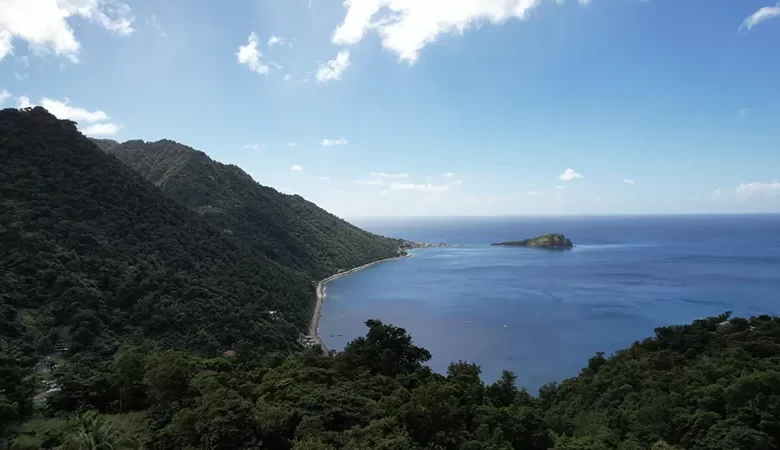Dominica’s Biodiversity

Dominica, known as the Nature Island of the Caribbean, boasts one of the most diverse ecosystems in the region, featuring habitats ranging from lush mountainous rainforests to volcanic landscapes. Its thriving biodiversity includes numerous endemic species, unique flora and fauna, and an array of ecosystems critical to the island’s ecological balance and Tourism Industry. The government and several local and international organisations have worked tirelessly to protect Dominica’s natural heritage, mainly through conservation and sustainable development programs.
Flora: Trees, Plants, and Flowers
Dominica’s forests are home to many trees, including the Bwa Mang, Karapit Tree, Cannonball Tree, Gommier, Chatannyé Tree, and Mang Blan, found along popular hiking trails such as the Boeri Lake Trail and Syndicate Nature Preserve. These trees are vital to the island’s biodiversity, providing habitats for various birds, insects, and mammals. Among the island’s more notable tree species is the Bwa Dyab, often seen along the Waitukubuli National Trail, which is revered for its strength and significance in local folklore.
The island is home to a wide variety of flowering plants, including Heliconias (Heliconia caribaea), Birds of Paradise (Strelitzia reginae), Ginger Lilies (Hedychium coronarium), and vibrant Hibiscus (Hibiscus rosa-sinensis). These striking plants thrive in the Dominica Botanic Gardens and Emerald Pool. Along forest floors, wild orchids and giant anthuriums flourish, adding splashes of colour to the moss-covered boulders, contributing to the island’s rich floral diversity and ecological balance.
Fauna: Birds, Mammals, Reptiles
Dominica is home to over 167 species of birds, including two endemic species—the Sisserou Parrot (Amazona imperialis) and the Jaco Parrot (Red-necked Amazon). The Sisserou Parrot in areas like Morne Diablotin National Park has become a national symbol and is featured on the country’s flag. These parrots depend on the island’s intact rainforests for survival, with reintroduction programs helping boost their populations.
Birdwatchers can also spot other notable species, such as the Wamyé, Sikiyé, and the Foufou – Tikyap – Lamouchè throughout the island, especially in areas like the Morne Trois Pitons National Park. Along the trails, visitors might also encounter the Mòwi, Gwiv-a-liné and the elusive Twanblè, each contributing to the island’s rich birdlife.
In addition to birds, Dominica’s mammals include species like the Agouti and the Manicou (a member of the possum family), both of which are commonly found in the island’s forested regions. Dominica also boasts a wealth of reptiles, such as the Lesser Antillean Iguana and several species of turtles, particularly along the island’s coastal areas.
Insects in Dominica
Dominica hosts over 55 species of butterflies in the insect world, many thriving in the island’s forested areas. These include the Antillean Crescent (Anthanassa frisia), known for its striking crescent patterns, and the Papillon Zébré (Zebra Longwing), recognized by its black and white stripes. Dominica is also home to a variety of beetles such as the Bèt Gran (Hercules Beetle), one of giant beetles in the world.
Among the island’s ant species, the Leaf-cutter Ant (Atta cephalotes), locally called “Fourmi-Tè”, is notable for its remarkable leaf-cutting abilities. Another common ant is the Fire Ant (Solenopsis invicta), known for its painful sting and aggressive behaviour. Dominica’s moth population includes the Death’s-head Hawkmoth (Acherontia atropos), famous for the skull-like pattern on its thorax, and the Tobacco Hornworm Moth (Manduca sexta), often seen in local gardens and known for its large size and destructive larvae.
These insects, along with spiders like the Golden Orb-Weaver (Nephila clavipes) and centipedes such as the Scolopendra gigantea, known locally as “Centopied”, play vital roles in Dominica’s ecosystems, contributing to the island’s rich biodiversity
Waterways: Rivers, Waterfalls, and Sulphur Springs
Dominica’s waterways are central to its ecosystem. With 365 rivers—one for every day of the year—these waterways include prominent rivers like the Layou River, Indian River, Check Hall River, and the Roseau River. Rivers such as the Pagua River and the Massacre River flow through the island’s rich valleys, providing fresh water to both the natural environment and local agriculture.
Dominica is also famous for its waterfalls, including the towering Trafalgar Falls, the pristine Spanny Falls, and the dramatic Middleham Falls. These cascading waterfalls from the island’s volcanic heights are essential to the island’s sports tourism and draw hikers and nature lovers worldwide.
Dominica’s volcanic origins are evident in its many sulphur springs, including Cold Soufrière, and the Boiling Lake is one of the island’s most famous natural attractions. Other hot springs, such as those in Wotten Waven, offer a more relaxing experience, where visitors can enjoy therapeutic baths amidst stunning natural landscapes.
Marine Life: Fishes, Crustaceans, and Coral Reefs
Dominica’s marine biodiversity is as rich as its terrestrial life. Thriving coral reefs surround the island, and it is famous for being home to sperm whales, which can be seen year-round off the coast. The Dominica Sperm Whale Project works to study and protect these majestic marine mammals.
In the surrounding waters, various species of fish, such as parrotfish, groupers, and snapper, inhabit the coral reefs, while lobsters, crabs, and conch are commonly found on the island. The Indian River and coastal areas like Sandy Bay provide the ideal environment for species like the blue crab and other freshwater and marine creatures.
Parks, Forests, and Protected Areas
A network of national parks and conservation areas protects Dominica’s rich biodiversity. The Morne Trois Pitons National Park, a UNESCO World Heritage Site, is one of the island’s crown jewels. It protects some of the island’s most pristine landscapes, including the Valley of Desolation and Boeri Lake. The park is a haven for nature lovers and is home to several of the island’s endemic species.
The Morne Diablotin National Park is another essential part of the island’s conservation strategy, protecting the habitat of the Sisserou Parrot and other endangered species. This park, named after Dominica’s highest peak, offers breathtaking views and challenging hikes through its dense forest ecosystems.
In addition to these national parks, smaller reserves like the Central Forest Reserve and the Cabrits National Park Marine Section play crucial roles in protecting the island’s terrestrial and marine biodiversity.
Fruits, Agriculture, and Traditional Knowledge
Dominica is also famous for its wide array of fruits and agricultural products. The island’s tropical climate allows for cultivating bananas, plantains, mangoes, papayas, and the Mammee Apple, commonly seen in local markets. Breadfruit, soursop, and cocoa thrive in the island’s fertile volcanic soil.
Local farmers often cultivate these crops using traditional methods, drawing on agrobiodiversity practices passed down through generations. Agribusinesses like Benjo’s Seamoss & Agro-Processing Co Ltd, Bee Natural, and Bannis Farm Products work to promote sustainable farming practices, ensuring the long-term health of both the environment and the island’s agricultural economy.
Conservation Organizations and Government Initiatives
A combination of government bodies and non-governmental organizations supports the preservation of Dominica’s biodiversity. The WAVE (Waitukubuli Advocate for Viable Environment), WildDominique, Dominica National Conservation Trust Fund, and the Forestry, Wildlife, and Parks Division work closely with international partners like the Caribbean Biodiversity Fund to secure funding and implement conservation projects.
These organizations focus on several critical areas, including protecting marine ecosystems, which resulted in the formation of the Soufriere Scotts Head Marine Reserve, Salisbury Marine Reserve and Cabrits National Park Marine Section, supporting reforestation efforts and ensuring the sustainable use of natural resources. Conservation initiatives are also focused on mitigating the impacts of climate change, with projects aimed at improving the resilience of local communities and ecosystems.
Conclusion: Dominica’s Future in Conservation
Dominica’s extraordinary biodiversity is a source of pride for the island and a crucial asset for future generations. Through the collaborative efforts of the government, local communities, and international partners, Dominica continues to make significant strides in protecting its natural heritage. As the island faces challenges from deforestation, climate change, and invasive species, ongoing conservation efforts will be essential in ensuring that the Nature Island retains its ecological richness for years to come.




